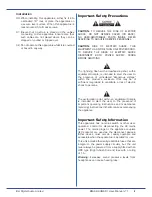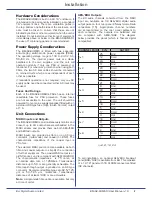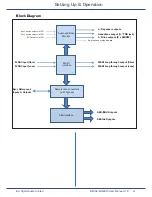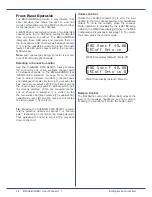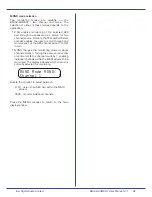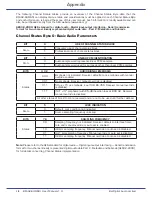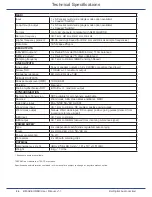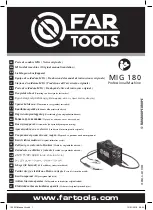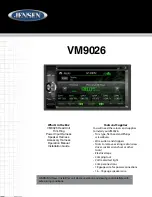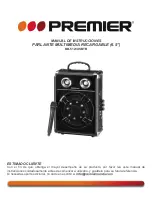
BM-A2-64MADI User Manual v1.0
18
Bel Digital Audio Limited
The following Channel Status tables provide an overview of the Channel Status Byte data that the
BM-A2-64MADI can display.Various notes and considerations must be applied to each Channel Status Byte
and such information is beyond the scope of this user manual. Such information is readily available and can
also be purchased directly from the AES website (www.aes.org).
AES3-2-2009: AES standard for digital audio - Digital input-output interfacing - Serial transmission
format for two-channel linearly-represented digital audio data - Part 2: Metadata and Subcode
Channel Status Byte 0: Basic Audio Parameters
BIT
0
USE OF CHANNEL STATUS BLOCK
State
0
Consumer use of channel status block.
1
Professional use of channel status block.
BIT
1
LINEAR PCM IDENTIFICATION
State
0
Audio sample word represents linear PCM samples.
1
Audio sample word used for purposes other than linear PCM samples.
BITS
4 3 2
AUDIO SIGNAL EMPHASIS
States
0 0 0
Emphasis not indicated. Receiver defaults to no emphasis with manual
override enabled.
0 0 1
No emphasis. Receiver manual override is disabled.
0 1 1
50 µs + 15 µs emphasis, see ITU-R BS.450. Receiver manual override
is disabled.
1 1 1
ITU-T J.17 emphasis (with 6,5-dB insertion loss at 800 Hz). Receiver
manual override is disabled
All other states of bits 2 to 4 are reserved and are not to be used until further defined.
BIT
5
LOCK INDICATION
State
0
Default. Lock condition not indicated.
1
Source sampling frequency unlocked.
BITS
7 6
SAMPLING FREQUENCY
States
0 0
Sampling frequency not indicated. Receiver default to interface frame
rate and manual override or auto set is enabled.
1 0
48 kHz sampling frequency. Manual override or auto set is disabled.
0 1
44.1 kHz sampling frequency. Manual override or auto set is disabled.
1 1
32 kHz sampling frequency. Manual override or auto set is disabled.
Note:
Please refer to the AES standard for digital audio — Digital input-output interfacing — Serial transmission
format for two-channel linearly represented digital audio data Part 2: Metadata and Subcode (AES3-2-2009),
for full details concerning Channel Status implementation.
Appendix


